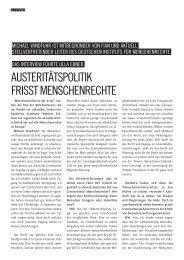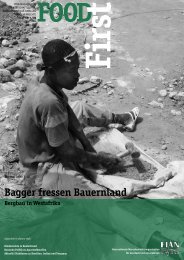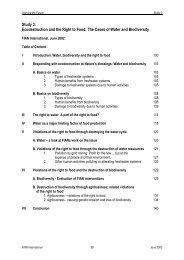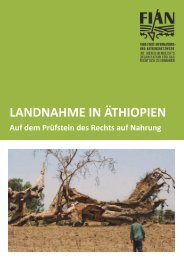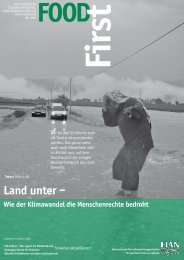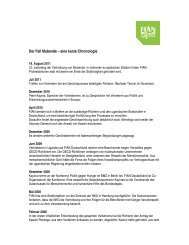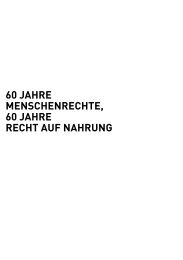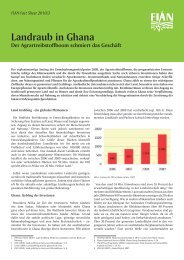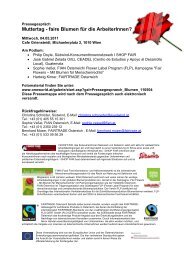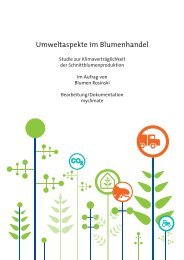(Bio)Fueling Injustice? - Europafrica
(Bio)Fueling Injustice? - Europafrica
(Bio)Fueling Injustice? - Europafrica
Create successful ePaper yourself
Turn your PDF publications into a flip-book with our unique Google optimized e-Paper software.
2. The evolution since 2010: the rising<br />
phenomenon of land grabbing and its negative<br />
impact<br />
2.1. New evidence confirms the scale of the phenomenon<br />
The Monitoring report already showed that land grabbing is a wide scale phenomenon<br />
in Africa. Without overemphasising quantitative approaches, since 2010 research has<br />
produced new estimates on the scale of the rush for land. It seems that it is greater<br />
than originally expected, especially in Africa. A 2011 analysis from the World Bank<br />
analysing media reports estimates that investors expressed interest in 56.6 million<br />
hectares (ha) of land globally between October 2008 and August 2009. Of these<br />
projects, two thirds of them, or nearly 40 million hectares, involves Sub-Saharan<br />
Africa. 12 Still in the same report, a country-specific inventory of official data on actual<br />
and pending land transfers in 2004-09 shows that investors acquired or expressed<br />
interest in 10.2 million ha in five African countries during the period (Ethiopia,<br />
Liberia, Mozambique, Nigeria, and Sudan). 13 A finer analysis of these results by the<br />
authors shows that the biggest flow of investments is between investors based in<br />
Europe and Central Asia for acquisitions in Africa, thus confirming the importance to<br />
monitor land grabbing on the continent. 14 These figures also demonstrate a sudden<br />
and huge demand for African land, as the annual rate of area expansion in Africa was<br />
only of some 1.8 million ha in 1961-2007 – compared to 39.7 million ha in 2009<br />
alone. 15<br />
The International Land Coalition set up the Land Matrix project to monitor largescale<br />
land transactions from 2000-2010. In this period, the project finds a total of 203<br />
million ha of large-scale (more than 200 ha) land acquisitions. Of these, 71 million ha<br />
had been cross-checked from multiple sources and confirmed as of December 2011.<br />
Africa again appears to be the most impacted region, with almost half of the crosschecked<br />
deals (34 million ha) taking place in the continent.<br />
A group of experts set up by the UN Committee on World Food Security, the High<br />
Level Panel of Experts (HLPE) endorsed similar figures in July 2011 (50-80 million<br />
ha globally), noting that “all sources agree that the trend is markedly upward and is<br />
likely to continue.”<br />
The drivers of this rush for land are known. The triple crisis (food, financial, oil) played<br />
a key role, as analysed in the Monitoring report. The food crisis incentivised rich foodimporting<br />
countries to invest in land to ensure their own food security and the<br />
limitations of oil production motivated the development of agrofuels. These two<br />
phenomena together contributed to raise the value of land, which has by consequence<br />
driven speculative investment in land, in the context of the global financial crisis where<br />
investors seek new reliable sources for financial returns. Taking a different typology,<br />
the HLPE highlights three drivers to the rush for land: 16 public policies on food and<br />
biofuels – including the African Union (AU) Comprehensive African Agricultural<br />
Development Programme (CAADP) of 2003 which committed member state<br />
governments to invest 10% of government expenditure in the agricultural sector;<br />
25



